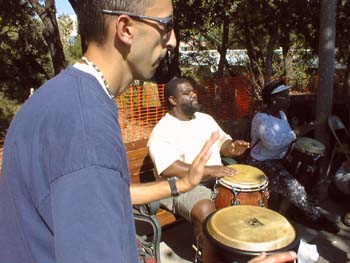![[Metroactive Features]](/features/gifs/feat468.gif)
![[Metroactive Features]](/features/gifs/feat468.gif)
[ Features Index | Metro | Metroactive Central | Archives ]
Carnaval Atmosphere
 Different drummers and cultures converge at peaceful Afribbean Festival By J. Douglas Allen-Taylor
AROUND 3 O'CLOCK on Saturday afternoon the valley sun dropped so low and hot over the Guadalupe River Park in San Jose that it almost seemed to push the Southwest Airlines planes down out of the sky. The crowd had begun to swell in the grass in front of the stage at the Afribbean Festival, a rhythm-splash of bare arms and legs and swaying colors. While a reggae/Caribbean band whirly-dervished their way back and forth across the stage, a tiny older black man carved his own space down behind the crowd barrier. African? African American? Caribbean? Who could tell? He danced himself tropical-sweaty in his own little space--all African print pants and shirt and snakeskin boots--while the crowd admired him and cheered and a few folks walked past to give him a high five. And by no means was he the only one having a good time at last weekend's Afribbean Festival. Entrance to the park was free and no one was taking a head count, but certainly several thousands of people walked along the Guadalupe over the course of the two-day event to dance in the grass, buy statues or incense or fabric in the bright surrounding bazaar of merchant booths, or feast on jerk chicken or Cajun fries. You could not walk five steps in any direction without bumping into a Bob Marley song. Formal entertainment was divided between the main stage and a DJ dance tent, both of which were packed to capacity by the end of each day, but here and there inside the grounds people brought their own drums and shakarees and made their own music where they sat, so that there were small explosions of rhythm and song breaking out wherever you walked, all over the park. This is the sixth year of the South Bay's Afribbean, begun in 1993 in the parking lot at Alberto's Nightclub in Mountain View. In '94 the festival moved to Castro Street in downtown Mountain View, and sponsors estimate last year's attendance at 70,000. This year's celebration was the first to be held in both Mountain View, in July, and in San Jose. Representatives of Global Culture & Arts Inc. of Mountain View, the festival's nonprofit sponsoring organization, say that the word Afribbean is a combination of African and Caribbean, and the purpose of the festival is to celebrate the shared music and cultural traditions of those two parts of the world. Interestingly, the organizer and executive director of Global Culture & Arts, Jetin Grewal, is neither African nor Caribbean but rather East Indian, though she gives a pretty good Trinidadian accent over the phone. Grewal, who works as the administrator of a veterinary hospital in Sunnyvale, says she was hooked on Afro-Caribbean music long before she came to the United States from India in 1984. She says that she and her former husband began the Afribbean festival partly because there was no other such event that celebrated African drumming or "the Caribbean carnaval atmosphere" in the South Bay, and partly because the Afro-Caribbean community in the South Bay is "so scattered" and needed a way to be brought together. "A lot of events like New Orleans by the Bay are incorporating carnival and drumming," Grewal says. "But we were the first." And by far the best, so far. One of the more remarkable things about the San Jose Afribbean festival was that despite prominent advertising by Heineken Beer and Captain Morgan Original Spiced Rum (the Captain was thoughtful enough to put up two 25-foot inflated replicas of rum bottles on the festival grounds, just in case we missed the point), alcohol abuse did not appear to be a problem at the event. Grewal says her group made no special effort to control drinking, which often gets out of hand at public gatherings, and she searched around for a reason why Afribbean was trouble-free. "I think it's how we market the event," she finally says. "We advertise in publications and radio stations whose audience is more mature. We try to get families out." Large numbers of teenagers and young adults did attend, trading admiring looks and pager numbers especially around the DJ tent. But mixed in with the older folks and the little children with face-paintings and bright balloons, the teenagers gave off none of that dangerous aura you get at the average rock or summer jam concert at Shoreline. Remarkably, in these days and times, they blended in nicely as part of a greater community. None of them could keep up with the energy of the older man dancing in the grass in front of the stage, though. After a while he pulled off his hat and African shirt and tossed them against the fence, and the interlaced muscles in his arms and back looked like tight black rope. The crowd around cheered, and he danced and danced and danced as the music swung from calypso to reggae to soca to salsa and back again. And when I finally had to go and walked out of the park and back toward downtown, I could hear the drumming following me up San Carlos, all the way, almost, to First Street, and I thought of that man and figured he was back there in front of the bandstand, listening to the festival music, gyrating his skinny body, dancing still. [ San Jose | Metroactive Central | Archives ]
|
Copyright © Metro Publishing Inc. Maintained by Boulevards New Media.
![]()